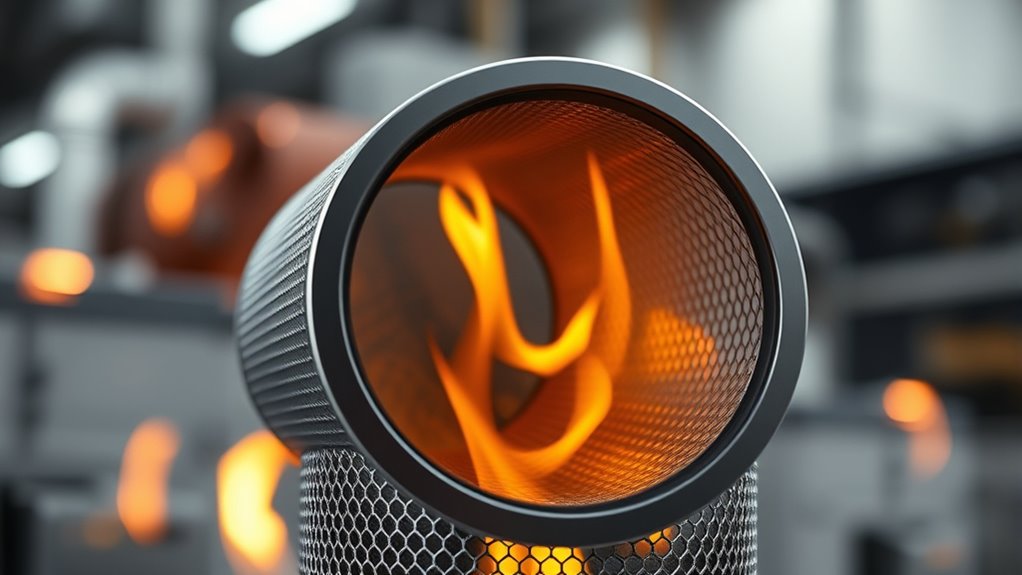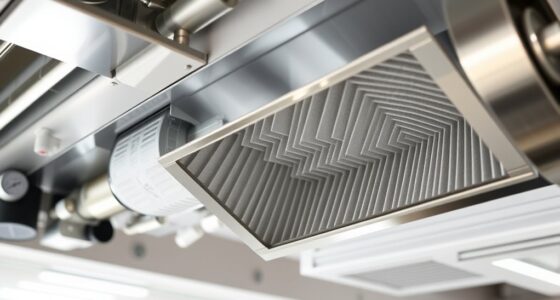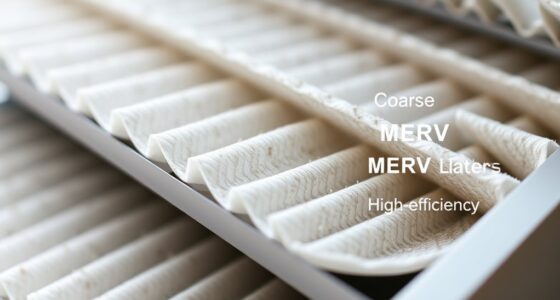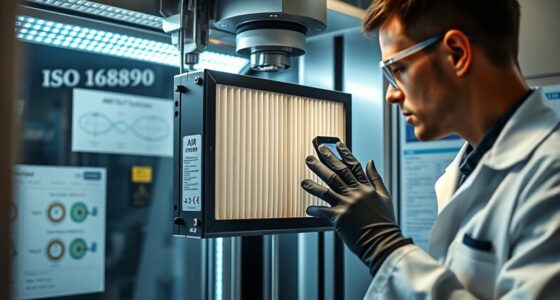UL 900 sets fire resistance standards for air filters used in HVAC systems, ensuring they resist ignition, melting, and flame spread during fires. These standards help protect buildings and their occupants by confirming filters can maintain safety and integrity under fire conditions. Manufacturers must certify their materials meet these strict criteria, which reduces fire risks and complies with safety codes. To find out more about how UL 900 standards enhance fire safety, keep exploring the details behind these certifications.
Key Takeaways
- UL 900 establishes fire resistance testing criteria for air filters used in HVAC systems.
- It assesses filters’ ability to resist ignition, melting, and flame spread during fire exposure.
- Certification confirms filters meet strict fire safety standards, ensuring building occupant protection.
- Manufacturers must demonstrate material fire-resistant properties through rigorous testing for UL 900 compliance.
- Using UL 900 certified filters helps ensure regulatory compliance and reduces fire-related risks in buildings.
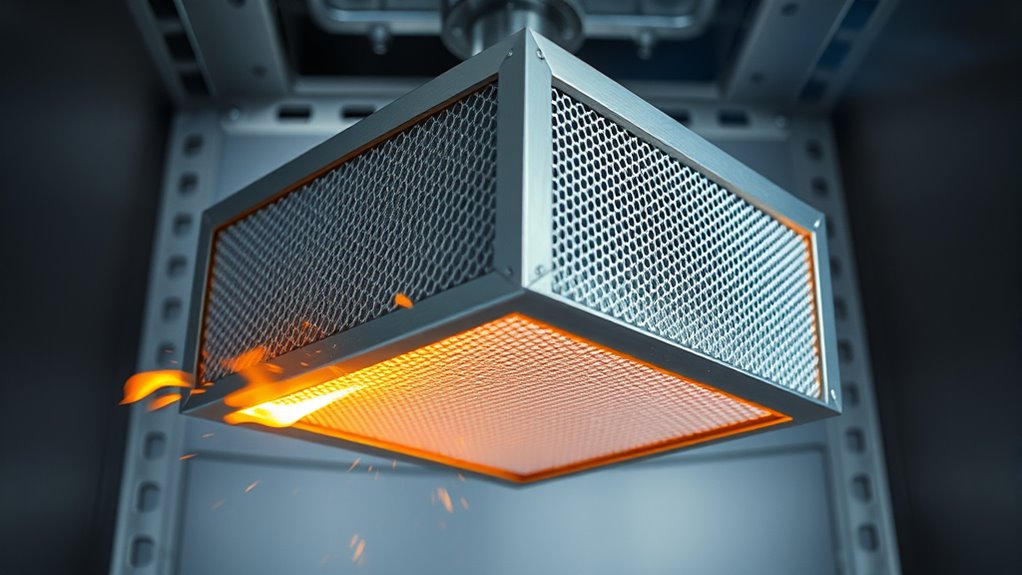
Understanding UL 900 fire resistance standards for air filters is essential for guaranteeing building safety and compliance. These standards are designed to evaluate how well air filters resist fire and prevent the spread of flames within HVAC systems. When selecting filters for your building, you need to be aware of the fire testing processes that determine whether a filter meets UL 900 requirements. Fire testing involves exposing the filter to specific fire conditions to observe its behavior, such as whether it ignites, melts, or contributes to flame spread. This testing provides crucial data to guarantee that the filter can withstand fire hazards and maintain the safety of occupants and property. Additionally, fire testing procedures are continually updated to reflect new safety challenges and technological advancements. Material certification plays a significant role in meeting UL 900 standards. Manufacturers must demonstrate that their filter materials are fire-resistant through rigorous testing and certification processes. These certifications verify that the materials used in the filter construction have been tested and approved for fire resistance, giving you confidence in their safety performance. When a filter carries UL 900 certification, it indicates that it has successfully passed fire testing and adheres to the strict criteria set by UL (Underwriters Laboratories). This certification is vital because it confirms the product’s ability to maintain integrity during a fire, preventing the spread of flames and smoke through the HVAC system. As a building owner or manager, understanding the importance of fire testing and material certification helps you make informed decisions. Not all filters are created equal—some may meet minimum filtration standards but lack fire-resistant properties. By choosing filters that are UL 900 certified, you guarantee compliance with fire safety codes and reduce risks associated with fire hazards. These filters are designed to be used in environments where fire safety is a priority, such as hospitals, schools, or commercial buildings with high occupancy. Furthermore, UL 900 certification isn’t just a checkbox; it’s a commitment to safety and quality. It requires ongoing testing and quality assurance from manufacturers, which helps maintain high standards in fire resistance performance. When you install UL 900-compliant filters, you’re not only adhering to regulations but also protecting your building’s occupants and assets from the dangers of fire spread. This proactive approach minimizes potential damage, costly repairs, and liability issues associated with fire incidents.
Frequently Asked Questions
How Often Should Fire Resistance Testing Be Renewed for Compliance?
You should renew fire resistance testing every one to three years to maintain compliance. Regular testing guarantees your air filters continue to meet safety standards and stay up-to-date with UL 900 requirements. Keep track of your testing schedule and promptly renew it to avoid compliance issues. Staying consistent with testing frequency helps you maintain safety, meet regulatory expectations, and ensure that your air filters provide reliable fire resistance performance over time.
Are UL 900 Standards Applicable Worldwide or Only in Specific Regions?
Imagine a globe wearing a tiny firefighter helmet—UL 900 standards are like that, mostly seen in specific regions. These fire resistance standards are primarily regional, tailored to local safety regulations. However, many international standards bodies recognize UL 900, making it influential worldwide. So, while it’s not universally mandated, adopting UL 900 can boost your product’s credibility and safety reputation across various markets.
What Are Common Challenges Faced During Fire Resistance Testing?
During fire resistance testing, you often face challenges like material degradation, which can affect the filter’s integrity and safety. Ensuring testing consistency is also tough, as variations in equipment or procedures may lead to unreliable results. You need to carefully control testing conditions and monitor material performance closely to get accurate, repeatable data. These challenges highlight the importance of meticulous procedures in fire resistance assessments.
How Does UL 900 Compare to Other Fire Resistance Standards?
Did you know UL 900 is one of the few standards that specifically addresses air filter fire safety? Compared to other fire resistance standards, UL 900 emphasizes testing protocols tailored for air filters, ensuring they resist fire without compromising airflow. While standards like ASTM or NFPA focus broadly on building safety, UL 900 provides specialized guidance, making it essential for manufacturers aiming to meet rigorous fire safety requirements in air filtration.
Can Existing Air Filters Be Retrofitted to Meet UL 900 Standards?
You can retrofit existing air filters to meet UL 900 standards, but you’ll face some challenges. Retrofitting mainly involves upgrading the filter material to fire-resistant options and ensuring proper sealing. Retrofitting challenges include compatibility issues with the original design and maintaining airflow efficiency. It’s often more practical to replace filters with UL 900-compliant models rather than attempting extensive retrofits, ensuring safety and compliance without compromising performance.
Conclusion
Understanding UL 900 fire resistance standards for air filters is vital for your safety and compliance. By ensuring your filters meet these standards, you’re not putting all your eggs in one basket—you’re safeguarding your environment against potential fire hazards. Don’t wait until it’s too late; staying informed and proactive is the best way to stay ahead of the game. Remember, a stitch in time saves nine, so prioritize fire-resistant filters today for peace of mind tomorrow.
